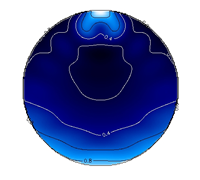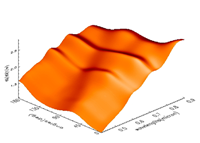 |
|
| Extended
Red Emission |
With the exception of some notable experiments performed on silicon nanoparticles, laboratory photoluminescence (PL) measurements on interstellar analogues are usually made on macroscopic samples or very thin films. The main problem in directly comparing ERE with such experimental data results from the fact that interstellar dust is a diluted dispersion of grains of sizes comparable to, or smaller than, the wavelength of the emitted light. Any attempts to quantify fluorescent signals from interstellar particles must carefully take into account the effect of particle size and optical properties. Differences between the PL properties of bulk samples and those of a small particle are about as large as that between the respective extinction properties, for just the same reasons. ACHG has so far developed a numerical model for studying the PL produced by small particles (Figures 1 and 2). With the output results of this model we are able to perform a direct comparison between laboratory PL measurements, made on bulk material, and astronomical observations of ERE spectra. So far, pretty large differences have been found when comparing the PL spectra of bulk material with the extrapolated values to small particles. The astrophysical implications of our numerical results are related to the explicit angular dependence obtained in our formulae. Our theoretical approach focuses on the impact of self-extinction
over the PL and a general recipe is derived to extrapolate laboratory
results obtained for bulk samples to the case of small particles.
Numerical results have been obtained for the simplest case of a spherical
homogeneous dust particle, in which a rigorous treatment of the extinction
is given by the well-known Lorenz-Mie theory. We are currently extending
our model to more realistic interstellar dust grains beyond the spherical
homogeneous dust model. This will be done by using more realistic
and sofisticated approaches such as the transition matrix method (collaboration
with the Messina Univ. Physics Dept.). |
Distribution of the EM energy absorbed inside a model spherical particle
Form factor modulating the spectral distribution of the experimental PL |

